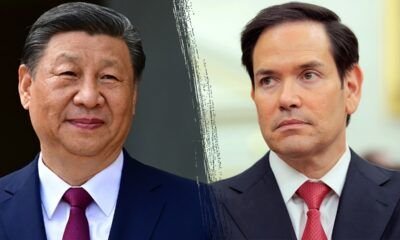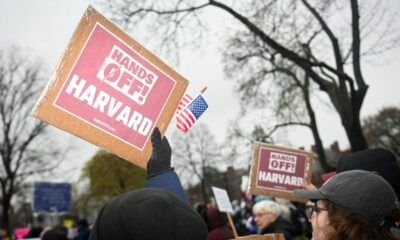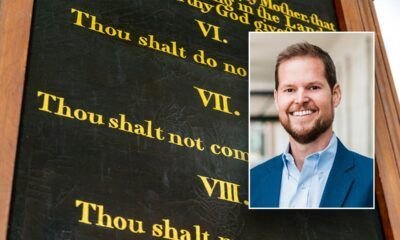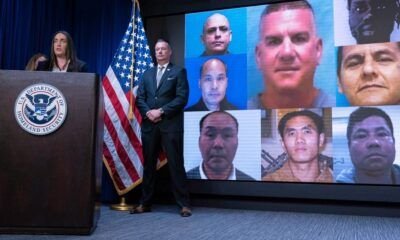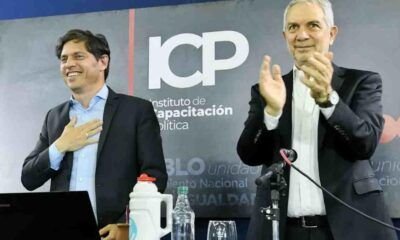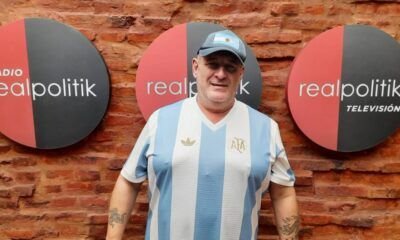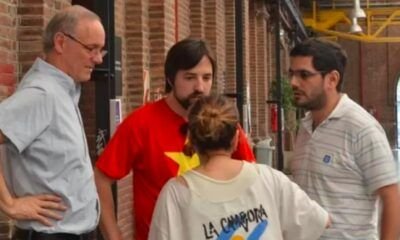INTERNACIONAL
‘Bad for parents’: School choice supporters protest exclusion of religious charter in Supreme Court case
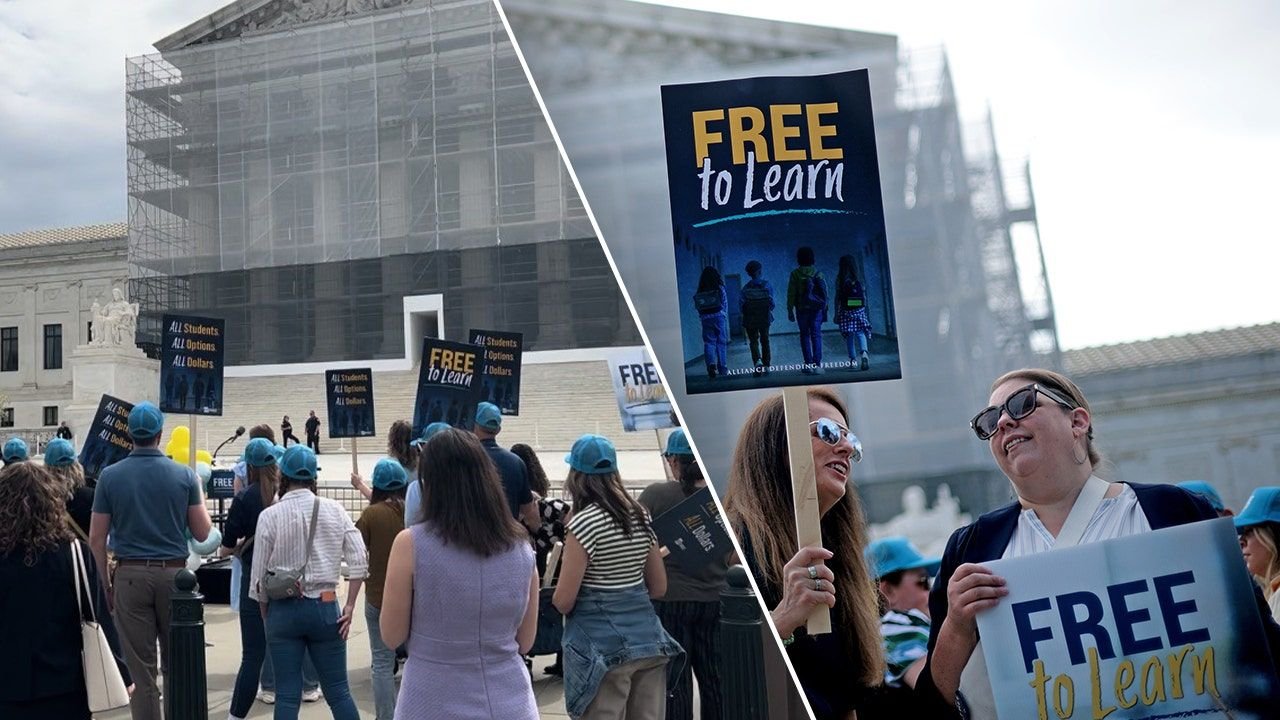
Dozens of school choice advocates gathered outside the Supreme Court Wednesday as justices weighed whether public funds could go directly to religious charter schools.
The protesters rallied and held signs that said «all students, all options, all dollars» and «free to learn,» as they advocated for expanded access to alternatives to traditional public schools, especially for students who struggle in those settings.
The case, St. Isidore of Seville Catholic Virtual School v. Drummond, challenges a ruling by the Oklahoma Supreme Court that struck down a contract establishing St. Isidore – a publicly funded, Catholic online school – as a violation of state and federal law. Now before the U.S. Supreme Court, advocates argue that excluding religious schools from state-run charter programs amounts to unconstitutional discrimination.
«The court has time and time again said that the Free Exercise Clause demands that the government treat religious and secular organizations the same, and that’s not what happened here. The state excluded St. Isidore simply because of its religious character, that’s wrong and bad for parents,» said Kate Anderson, an attorney at ADF working on the case.
LIBERAL SUPREME COURT JUSTICES GRILL RELIGIOUS INSTITUTION IN LANDMARK SCHOOL CHOICE CASE
School choice advocates rally outside the Supreme Court building on Wednesday, April 30. (Fox News Digital )
For students like Contina Jones’ son, public schools are not always a good fit. «He was very sad, very emotional every day, he was overstimulated, teachers were in and out, and I needed something that was able to cater to how my son learns,» said Jones, a Mississippi resident who joined the crowd outside the court. «Every child, regardless of zip code, should be able to go to a school that is for them for their families.»
The justices are being asked to weigh whether a religious charter school is entitled to the same treatment and funding as a secular one – a question that could redefine how states draw the line between church and state in public education.
«Charter schools are not public schools in the same way as traditional ones,» said Thomas Fisher, executive vice president of EdChoice. «They’re designed to have curricula other than what public schools provide. The First Amendment protects their free exercise and doesn’t prohibit them from exercising their religion.»
At issue is whether the school should be considered a public school – which have largely been considered as extensions of the state government, and required to be nonreligious under the Establishment Clause – or whether it should be considered private entities or contractors.
Oklahoma Attorney General Gentner Drummond, a Republican who is running for governor, filed the lawsuit against the school, stating that the establishment of St. Isidore would violate both the Oklahoma Constitution and the Establishment Clause of the U.S. Constitution. Public funds should not be used to support religious institutions, he emphasized, asserting that such a move could set a dangerous precedent for government endorsement of religion.
SUPREME COURT TO HEAR ARGUMENTS ON SCHOOL CHOICE CASE INVOLVING CATHOLIC CHARTER SCHOOL
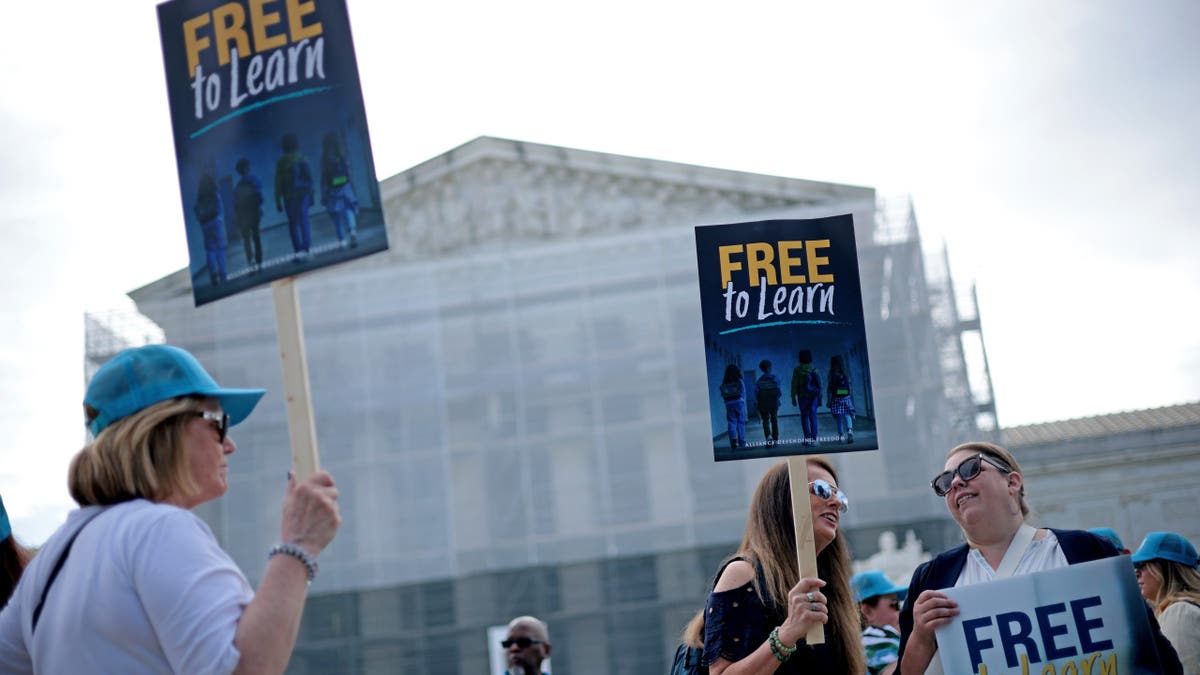
Supporters of St. Isidore hold signs outside the Supreme Court. (Alex Wong/Getty Images)
The Oklahoma Supreme Court agreed with Drummond’s assessment, ruling that charter schools are public entities and must remain nonsectarian. The court’s decision highlighted concerns that approving St. Isidore as a religious charter school could lead to state-sponsored religious indoctrination, undermining the neutrality of public education.
«The key here is that this school is its own school. This school is not a state school – it’s a charter school. It has the ability to set its own curriculum,» added John Tidwell, Oklahoma state director of Americans for Prosperity.
He called the case a «great test to see what the opportunity is for similar schools all across the country.»
«We’re really excited by this opportunity.»
Erika Donalds, chair of America First Policy Institute’s Center for Education Opportunity, echoed the sentiment, framing the case as a potential expansion of «the free market of education.»
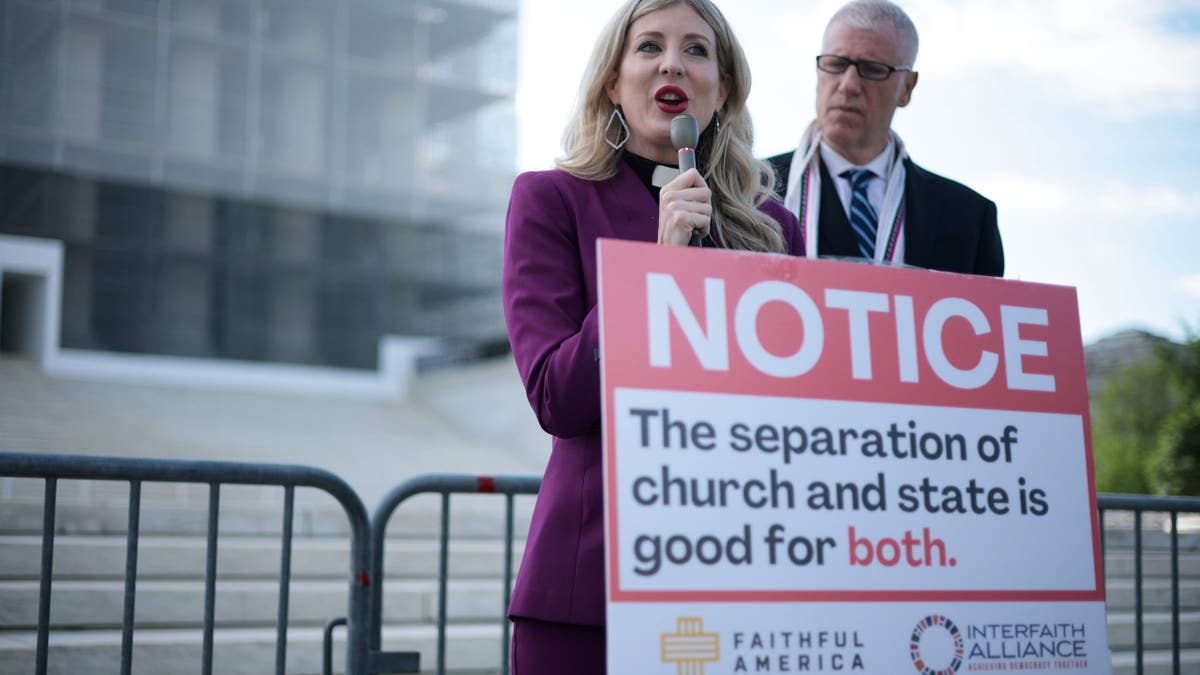
Rev. Shannon Fleck of Faithful America speaks as Rev. Paul Brandeis Raushenbush of Interfaith Alliance listens during a news conference outside the Supreme Court on April 30, 2025. (Alex Wong/Getty Images)
«St. Isidore is just one example of many high-quality options that are out there that could be chartered for families,» Donalds said. «The Supreme Court has struck down discrimination against religious institutions in other contexts. If they can offer high-quality education, families should be able to access those options with public funds.»
Donalds emphasized that the choice remains with families. «Parents are not required to choose a religiously affiliated charter school, but they should have the option to do so — so long as financial and academic accountability measures are met.»
CLICK HERE TO GET THE FOX NEWS APP
She also pointed to bipartisan support for school choice nationwide.
«We’ve seen polling that shows 70% of Republicans, nearly 70% of Democrats, and Independents all support school choice. This movement has momentum, and it’s not going to stop.»
The court’s ruling, expected by the end of June, could have sweeping implications for charter school policy and religious liberty jurisprudence across the country, and comes at a time when 45 U.S. states currently authorize charter schools.
Fox News’ Breanne Deppisch contributed to this report.
High School,US Education,Education Controversies,Supreme Court Oral Arguments,Supreme Court
INTERNACIONAL
Johnson says Hegseth possibly sending Marines to anti-ICE riots not heavy-handed: ‘Deterring effect’
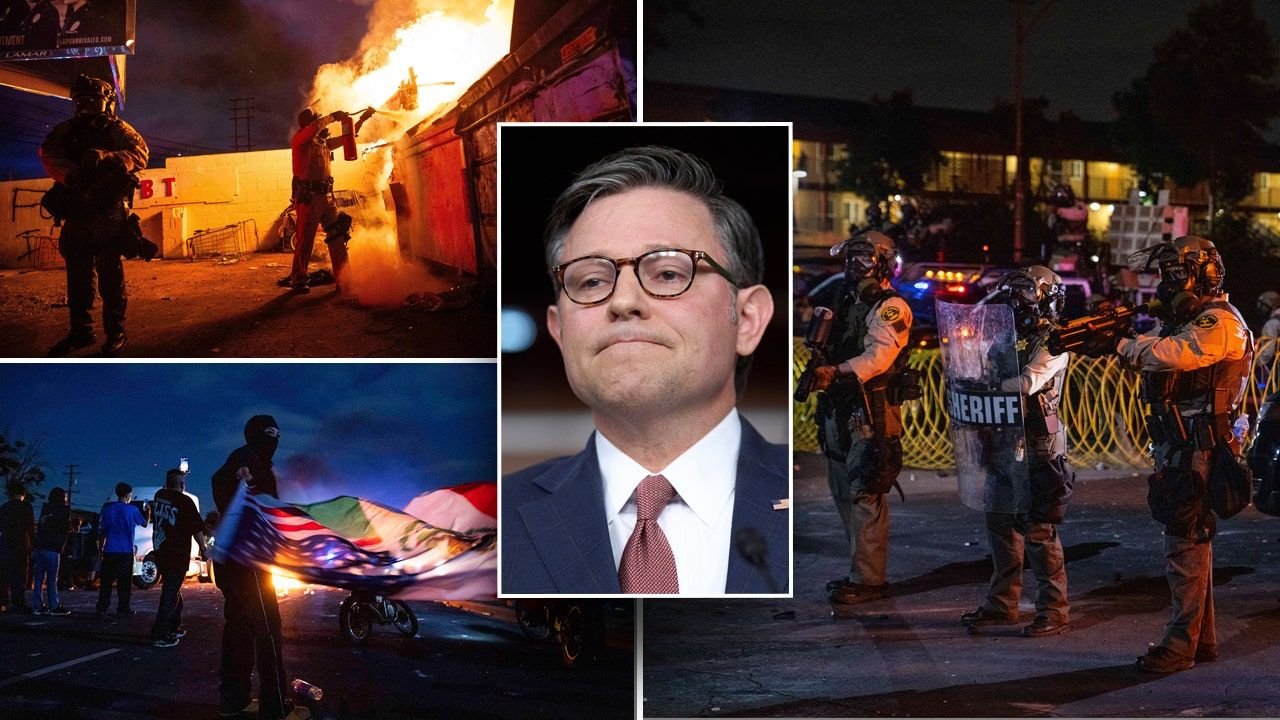
NEWYou can now listen to Fox News articles!
House Speaker Mike Johnson, R-La., said Sunday that Defense Secretary Pete Hegseth’s suggestion that he could send U.S. Marines to quell anti-Immigration and Customs Enforcement riots in Los Angeles would not be a heavy-handed approach.
In an appearance on ABC’s «This Week,» Johnson was asked to respond to President Donald Trump sending in National Guard troops to Los Angeles.
Trump said he would pursue the federal government taking control of the California National Guard if Gov. Gavin Newsom and Los Angeles Mayor Karen Bass «can’t do their jobs» to protect Los Angeles against rioting and looting.
«I have no concern about that at all,» Johnson told ABC host Jonathan Karl. «I think the president did exactly what he needed to do. These are federal laws and we have to maintain the rule of law, and that is not what is happening. Gavin Newsom has shown an inability or an unwillingness to do what is necessary there, so the president stepped in. That’s real leadership, and he has the authority and the responsibility to do it.»
PRESIDENT TRUMP SENDS NATIONAL GUARD AS VIOLENT ANTI-ICE RIOTS ERUPT IN LOS ANGELES
An officer works to put out a fire during a protest in Compton, California, on Saturday, June 7, 2025, after federal immigration authorities conducted operations. (AP Photo/Ethan Swope)
Karl also asked about a message posted by Hegseth, who wrote on X Saturday that the Department of Defense was mobilizing the National Guard «IMMEDIATELY to support federal law enforcement in Los Angles,» and «if the violence continues, active duty Marines at Camp Pendleton will also be mobilized – they are on high alert.»
«One of our core principles is maintaining peace through strength,» Johnson said in response Sunday. «We do that on foreign affairs and domestic affairs as well. I don’t think that’s heavy-handed. I think that’s an important signal….»
«You don’t think sending the Marines into the streets of an American city is heavy-handed?» Karl interjected.
«We have to be prepared to do what is necessary, and I think the notice that that might happen might have the deterring effect,» Johnson said.
Newsom responded to Hegseth’s threat on X, writing: «The Secretary of Defense is now threatening to deploy active-duty Marines on American soil against its own citizens. This is deranged behavior.»
«Deranged = allowing your city to burn & law enforcement to be attacked,» Hegseth hit back Sunday morning. «There is plenty of room for peaceful protest, but ZERO tolerance for attacking federal agents who are doing their job.»
«The National Guard, and Marines if need be, stand with ICE,» the defense secretary added.
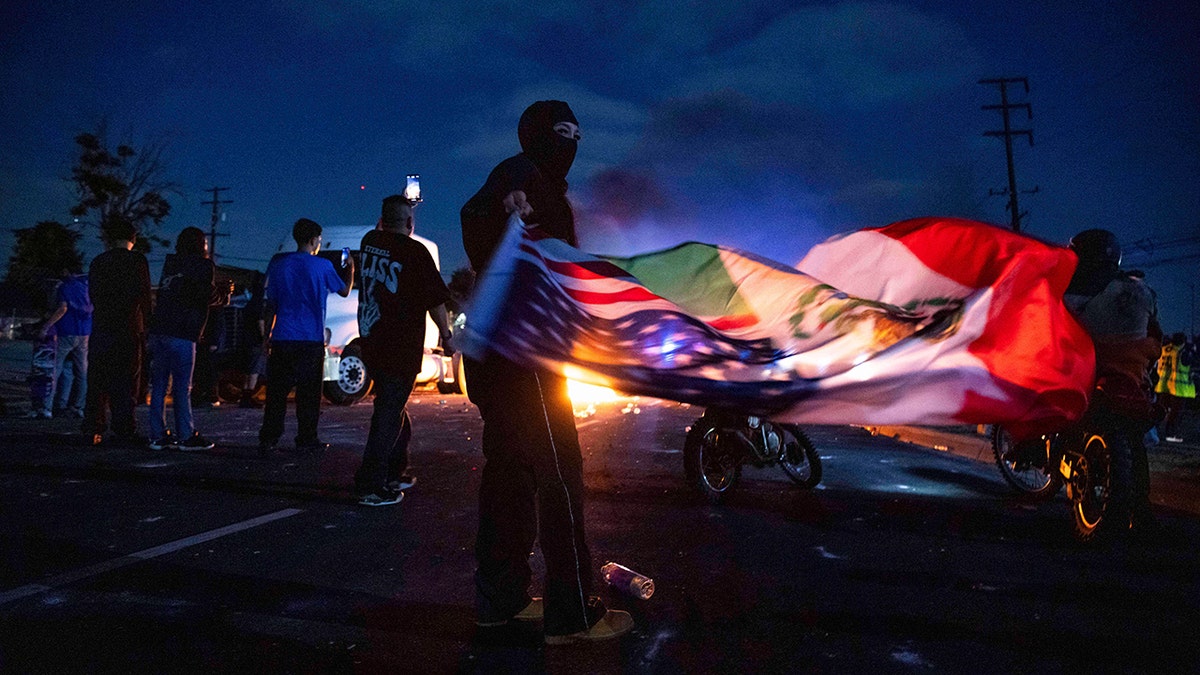
A demonstrator waves a U.S. and Mexican flag during a protest in Compton, California, on Saturday, June 7, 2025. (AP Photo/Ethan Swope)
In his initial message Saturday, Hegseth said, «The violent mob assaults on ICE and Federal Law Enforcement are designed to prevent the removal of Criminal Illegal Aliens from our soil; a dangerous invasion facilitated by criminal cartels (aka Foreign Terrorist Organizations) and a huge NATIONAL SECURITY RISK. Under President Trump, violence & destruction against federal agents & federal facilities will NOT be tolerated. It’s COMMON SENSE.»
Generally, the U.S. military is not allowed to carry out civilian law enforcement duties against U.S. citizens except in times of emergency.
SOCIAL MEDIA, TRUMP ADMIN ERUPTS OVER LA MAYOR’S REACTION TO ICE RAIDS: ‘YOU’RE A CRIMINAL TOO’
An 18th-century wartime law called the Insurrection Act is the main legal mechanism that a president can use to activate the military or National Guard during times of rebellion or unrest. But Trump didn’t invoke the Insurrection Act on Saturday.
Instead, the president’s memorandum called «into Federal service members and units of the National Guard under 10 U.S.C. 12406 to temporarily protect ICE and other United States Government personnel who are performing Federal functions, including the enforcement of Federal law, and to protect Federal property, at locations where protests against these functions are occurring or are likely to occur based on current threat assessments and planned operations.»
The federal law cited in the memo allows the president to federalize National Guard troops under three circumstances: When the U.S. is invaded or in danger of invasion; when there is a rebellion or danger of rebellion against the authority of the U.S. government, or when the president is unable to «execute the laws of the United States,» with regular forces. But the law also says that orders for those purposes «shall be issued through the governors of the States.»
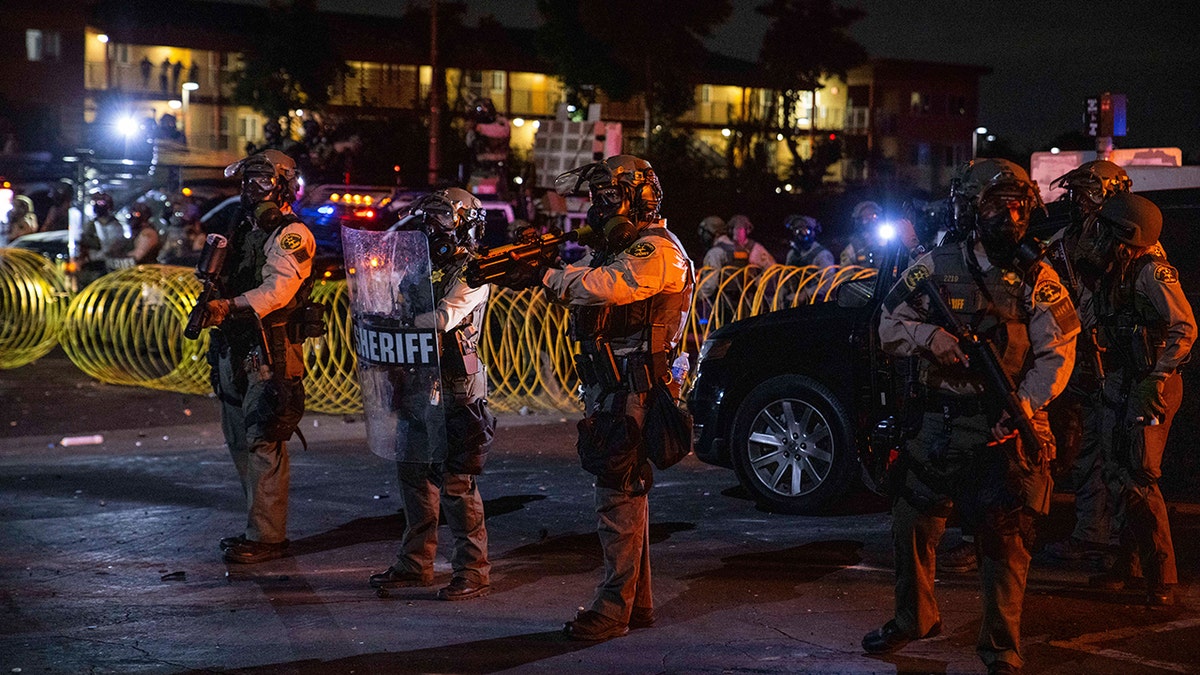
Los Angeles County sheriffs stand guard during a protest in Compton, California, Saturday, June 7, 2025. (AP Photo/Ethan Swope)
The National Guard is a hybrid entity that serves both state and federal interests.
It’s not immediately clear if the president can activate National Guard troops without the order of that state’s governor.
It’s also not clear if military personnel can be deployed.
Under the Posse Comitatus Act, troops under federal orders cannot be used for domestic law enforcement, but units under state control can. Enacted in the late 1800s during the Reconstruction period following the Civil War, the federal law limits the powers of the federal government to deploy the U.S. military for domestic law enforcement reasons «except in cases and under circumstances expressly authorized by the Constitution or Act of Congress.»
CLICK HERE TO GET THE FOX NEWS APP
Trump threatened to use the Insurrection Act during the height of 2020 rioting in the wake of George Floyd’s death, but ultimately did not do so. He did deploy federal agents to several U.S. cities, including Portland, where rioters attempted to breach a federal courthouse, clashing with law enforcement officers and targeting the building with Molotov cocktails and other projectiles for over 100 consecutive nights.
The Associated Press contributed to this report.
INTERNACIONAL
El Ejército israelí identificó el cuerpo de Mohammed Sinwar, jefe terrorista del ala militar de Hamas

Las Fuerzas de Defensa de Israel (FDI) confirmaron el domingo el hallazgo del cuerpo de Mohammed Sinwar, jefe del ala militar de Hamas, en una red de túneles subterráneos ubicada debajo del Hospital Europeo en Khan Yunis, en el sur de la Franja de Gaza.
Según un comunicado oficial de las FDI, el cuerpo de Sinwar fue localizado tras completarse un proceso de identificación en una operación dirigida del Comando Sur israelí. El militar palestino había sido eliminado el 13 de mayo de 2025, junto al comandante de la Brigada de Rafah, Mohammad Sabaneh, durante una operación conjunta de las FDI y la Agencia de Seguridad de Israel (ISA).
Las fuerzas israelíes indicaron que Sinwar se encontraba escondido en un centro de comando y control subterráneo en el momento del ataque, en una zona donde las tropas israelíes continúan operando actualmente.
Durante las búsquedas realizadas en la red de túneles subterráneos, las fuerzas israelíes localizaron varios objetos pertenecientes tanto a Sinwar como a Sabaneh, además de material de inteligencia adicional que fue transferido para investigación posterior. El comunicado militar también confirmó el hallazgo de cuerpos adicionales de terroristas, cuyas identidades se encuentran actualmente bajo examen.
Las FDI proporcionaron material audiovisual que documenta el proceso de localización de los cuerpos, así como imágenes de la extensa red de túneles descubierta bajo el hospital. El material incluye una ilustración tridimensional de la infraestructura subterránea y documentos que supuestamente pertenecían a Mohammed Sinwar.
Mohammed Sinwar, hermano menor del fallecido líder de Hamas Yahya Sinwar, había emergido como una figura clave en la estructura de mando de la organización terrorista tras la muerte de varios de sus dirigentes principales desde octubre de 2023.
Yahya Sinwar, acusado por Israel de ser el cerebro detrás del ataque del 7 de octubre de 2023 que desencadenó la guerra en Gaza, fue eliminado en el sur del territorio en octubre de 2024. Tras su muerte, los expertos consideraban probable que Mohammed Sinwar hubiera asumido el liderazgo interino de las Brigadas Ezzedine al-Qassam, el ala militar de Hamas, después de que su comandante Mohammed Deif fuera eliminado en julio de 2024.

Según informes de medios israelíes, Mohammed Sinwar comandaba la brigada de Hamas en la gobernación sureña de Khan Yunis desde 2005. La organización palestina había mantenido un estricto secreto sobre los nombres de sus altos mandos, particularmente del ala militar.

La naturaleza esquiva de las actividades de Sinwar le había valido los apodos de “la sombra” y “el fantasma”. Realizó muy pocas apariciones públicas, y según varios medios palestinos, no asistió ni siquiera al funeral de su padre en enero de 2022.
Los medios israelíes atribuían a Mohammed Sinwar un papel clave en el secuestro del soldado franco-israelí Gilad Shalit en 2006, así como en las negociaciones que llevaron a su liberación en 2011 a cambio de más de 1.000 prisioneros palestinos, entre ellos su propio hermano Yahya.
Un artículo del Wall Street Journal publicado en enero reportó que Sinwar había tomado el control de Hamas tras la muerte de su hermano, contrariando una decisión de los funcionarios de la organización con sede en Doha de establecer un consejo de liderazgo colectivo. Citando fuentes anónimas, el diario estadounidense indicó que Mohammed Sinwar había ayudado a reclutar nuevos combatientes y mantenía una línea dura en las negociaciones indirectas de alto el fuego entre Israel y Hamas.
El primer ministro israelí Benjamin Netanyahu había anunciado el 28 de mayo la eliminación de Mohammed Sinwar durante una sesión parlamentaria, describiendo el evento como parte de lo que denominó la “Guerra del Renacimiento”.
“En 600 días de la ‘Guerra del Renacimiento’, hemos cambiado efectivamente el rostro del Medio Oriente”, declaró Netanyahu ante el parlamento. “Expulsamos a los terroristas de nuestro territorio, entramos en la Franja de Gaza con fuerza, eliminamos a decenas de miles de terroristas, eliminamos… a Mohammed Sinwar”.
Los medios israelíes habían reportado inicialmente que Sinwar fue atacado en bombardeos aéreos israelíes cerca del Hospital Europeo en Khan Yunis el 13 de mayo. En ese momento, el ejército israelí había indicado que condujo “un ataque preciso contra terroristas de Hamas en un centro de comando y control ubicado en un sitio de infraestructura terrorista subterránea bajo el hospital europeo en Khan Yunis”.
La muerte de Mohammed Sinwar representó otro duro golpe a la estructura de liderazgo de Hamas. Desde octubre de 2023, Israel ha eliminado al jefe político de Hamas Ismail Haniyeh, al líder de su ala armada Mohammed Deif, además del mencionado Yahya Sinwar y una serie de otros comandantes y figuras políticas, debilitando considerablemente al grupo terrorista.
Los expertos consideraban que tras la muerte de varios líderes de Hamas desde el 7 de octubre, Mohammed Sinwar se encontraba en el centro de las decisiones sobre las negociaciones indirectas con Israel, la cuestión de los rehenes y la gestión del ala armada de Hamas.
Hamas está designado como una organización terrorista por Estados Unidos y la Unión Europea, entre otros.
INTERNACIONAL
Putin raises the stakes on ‘ghost fleet’ security, as NATO launches war games in the Baltic Sea

NEWYou can now listen to Fox News articles!
NATO navies are putting on a display of maritime might in the Baltic Sea this month, as thousands of personnel from 17 countries aboard 50 vessels take part in war games led by the U.S. Navy’s 6th Fleet.
Of the nine countries that share a Baltic Sea coastline, only Russia is not a NATO member, and June’s BALTOPS exercise aims to ensure those other countries can work together to defend the area, at a time when Moscow is turning up the heat.
«This year’s BALTOPS is more than just an exercise,» said U.S. Vice Admiral J.T. Anderson in a press release this week. «It’s a visible demonstration of our Alliance’s resolve, adaptability and maritime strength.»
Over the last year there’s been growing disquiet about Russia’s malign influence in the Baltic Sea region, with several incidents of severed undersea cables. Suspicion has fallen on Russia’s fleet of so-called «ghost» or «shadow» ships: hundreds of aging vessels, mostly oil tankers flying under foreign flags that are used to circumvent Western sanctions or trade in military hardware.
ESTONIAN SPY CHIEF DISCUSSES COUNTERING THREATS FROM RUSSIA
The USS Mount Whitney participates in exercise Baltic Operations as ships sail in formation through the Baltic Sea, June 5, 2025. (U.S. Navy Courtesy Photo)
There are also well-founded concerns that some of these ships are used for covert intelligence gathering, communication intercepts or to sabotage undersea infrastructure like internet cables or gas and electricity pipelines. Three crew members from a Cook Islands-registered vessel, believed to be part of Russia’s ghost fleet, are currently facing charges in Finland over damage to an undersea cable that prosecutors say happened when the ship dragged its anchor for 60 miles along the floor of the Baltic Sea.
«There’s a growing importance of the shadow fleet to Russia’s wartime economy, and a growing awareness that NATO needs to stop it,» Tony Lawrence, a naval expert and researcher at the International Centre for Defence and Security in Estonia, told Fox News Digital.
But after a number of NATO navies adopted a tougher stance against the ghost ships through stop-and-search tactics, the Russians announced they would use their own navy to escort the fleet through the Baltic Sea.
«The Russian military presence in the region has always been visible, this is not a new feature. However, what is new is that Russia is protecting its shadow fleet tankers in the narrow pass of the Gulf of Finland,» Finnish Defense Minister Antti Häkkänen said in a recent television interview with Finland’s YLE TV.
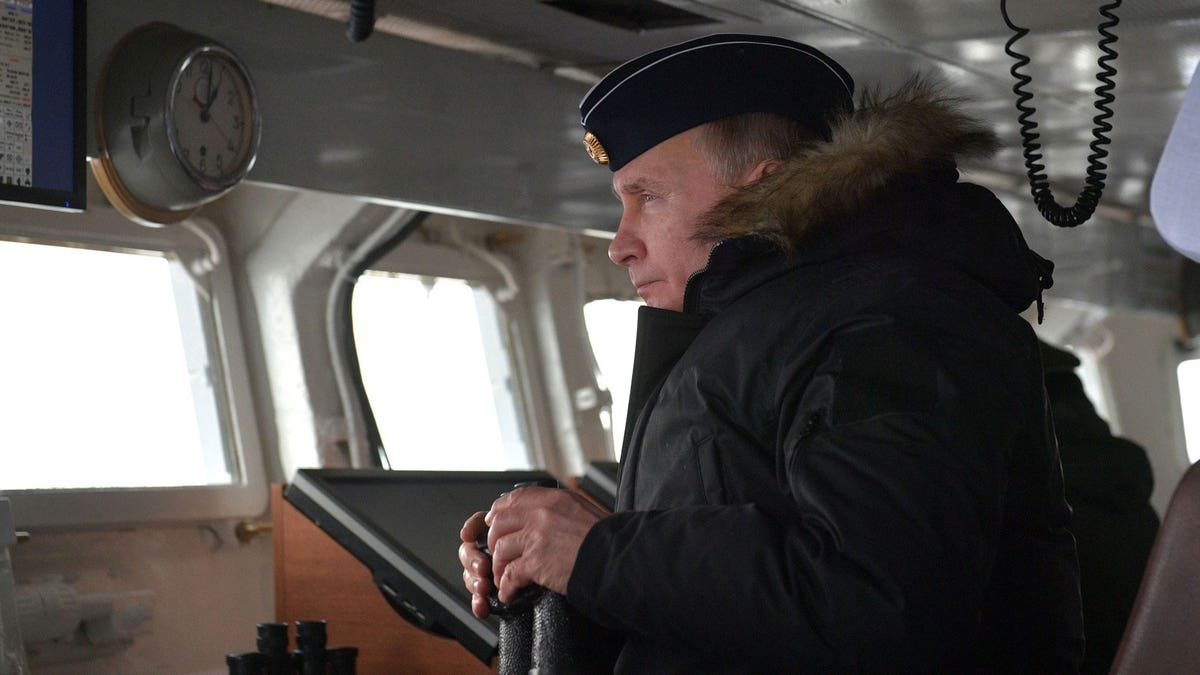
Russian President Vladimir Putin watches a naval exercise from the Marshal Ustinov missile cruiser in the Black Sea on Jan. 9, 2020. (Alexei Druzhinin/Russian Presidential Press and Information Office/Handout/Anadolu Agency via Getty Images)
NATO governments are keeping a close eye on the latest Baltic Sea developments and preparing for any possible increase in tensions. Danish Prime Minister Mette Frederiksen spoke at a meeting of NATO’s Nordic and Baltic members this week, and described the Russian threat as real and serious. «We see a more aggressive Russian approach in the Baltic Sea region,» she told reporters.
The Baltic Sea has relatively narrow waterways, where international maritime boundaries extend 12 miles from the coast, and Exclusive Economic Zones (EEZs) incorporate valuable fishing grounds or offshore wind farms. Add to this some of the busiest ferry routes in the world, commercial shipping traffic, military warships and civilian craft, and it raises the possibility that a more robust Russian naval posture in the area could increase the possibility of conflict.
«This is the risk of having more warships floating around the Baltic Sea, there is a potential for miscalculations that could escalate, and risk-reduction mechanisms that used to exist don’t work any more because the [NATO and Russian] navies aren’t talking to each other anymore,» Lawrence told Fox News Digital.
BALTIC SEA NATIONS VOICE CONCERN AS RUSSIA CONSIDERS REVISING MARITIME BORDER

The oil tanker Eagle S is seen anchored near the Kilpilahti port in Porvoo, on the Gulf of Finland on Jan. 13, 2025. (Vesa Moilanen/Lehtikuva/AFP via Getty Images)
Does the Russian navy even have the capacity to escort every single ghost fleet ship in the Baltic? That seems unlikely, according to some.
«It’s an escalation, of course, of Russian misbehavior in the Baltic Sea. But in practical terms I’m not sure it’s going to make that much difference,» Lawrence said.
«Russia’s Baltic Sea fleet has always been the junior cousin of the Russian navy, and it’s never been particularly well-equipped or enlarged, but it’s still the biggest national navy operating in the Baltic, and they have ships that are attuned to the Baltic Sea, which is shallow, and its salinity is such that you need special kinds of sensors. And they know how to hide ships in the archipelagos of Sweden or Finland, so in that regard, they have a certain amount of specialist capability,» Lawrence explained.
The Baltic Sea war games this month – with the U.S. Navy’s Arleigh Burke-class guided missile destroyer USS Paul Ignatius and the Blue Ridge-class command and control ship USS Mount Whitney taking part – serve to remind the Russians of the power of NATO’s combined naval assets in the region.
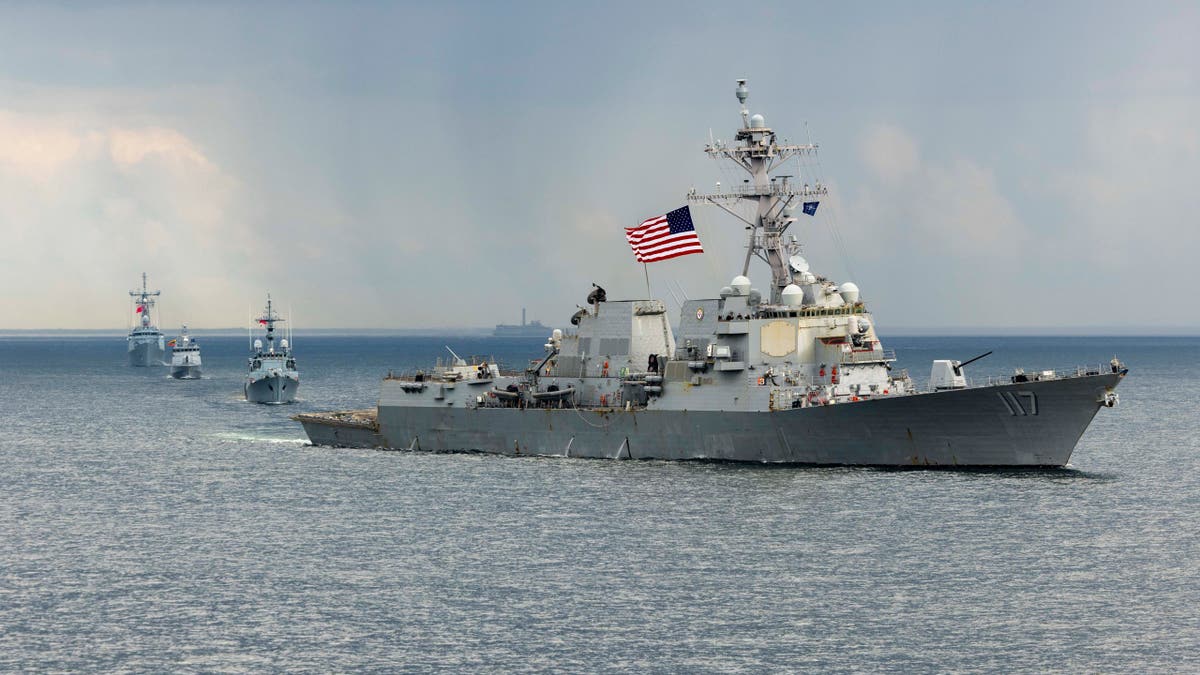
The guided missile destroyer USS Paul Ignatius participates in a steam formation with NATO ships during exercise Baltic Operations, June 5, 2025. (U.S. Marine Corps photo by Lance Cpl. John Allen)
And some of the smaller navies will be reassured by the presence of the American warships.
A few weeks ago, Estonia’s navy brought one suspected shadow fleet ship into its territorial waters for an inspection, and it complied. But when the Estonians tried the same tactic for a second time, the ship refused to stop and wouldn’t come into port.
CLICK HERE TO GET THE FOX NEWS APP
«That makes things more difficult for other nations because the shadow fleet is learning that it can just ignore what NATO navies do and there’s little that NATO can do in that situation, especially if there are Russian ships escorting the shadow fleet,» said Lawrence.
«But I don’t think NATO nations are going to back down. They will still follow and challenge these shadow fleet ships, or even look at other legislation, like requiring proof of insurance, to stop them from transiting the Baltic Sea.»
-

 CHIMENTOS3 días ago
CHIMENTOS3 días agoLa imperdonable actitud que Marcelo Tinelli tuvo con Coki Ramírez y que lo obligó a pedir perdón: «Fue horrible, me pidió disculpas»
-
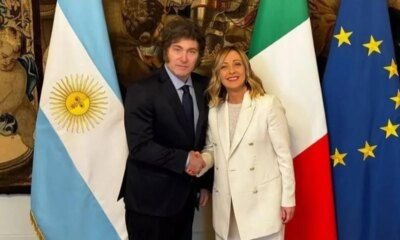
 ECONOMIA2 días ago
ECONOMIA2 días agoUn proyecto de u$s100.000 millones: claves del acuerdo entre Milei y Meloni para exportar gas de Vaca Muerta
-
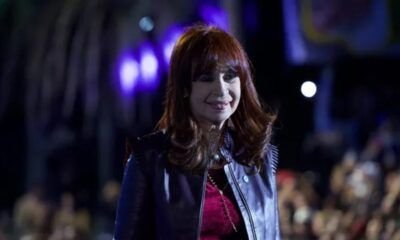
 POLITICA20 horas ago
POLITICA20 horas agoCristina Kirchner advirtió que la pueden “meter presa” y lo relacionó con su candidatura a diputada provincial






